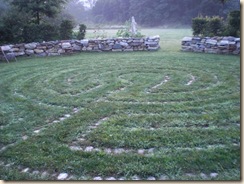I am excited to announce the public availability of the Place Keepers workbook, the project that inspired me to create this web site. In 16 pages, this workbook introduces the idea of green space and provides tools to help you get to know a specific local green space and get involved in its care. In making the workbook available for free and unrestricted use, I hope it can inspire individuals, community organizations, and local governments to strengthen their relationship with the land.
New location for a new outlook
As of October 1, 2009, I have consolidated my web presence at PlaceKeepers.org, a new site that better supports my current activities:
- Exploring the relationship of people to place
- Leading groups to labyrinths and other sacred spaces
- Consulting with Turtleflock LLC
I am no longer working professionally in desktop software support, but as time permits, I still answer a few Microsoft Outlook questions in online forums. See Looking for Outlook Help?
Labyrinths 11-17
I have updated the map of Labyrinths I Have Walked to include labyrinths from summer travels to Georgia, Pennsylvania, and New York, along with a couple in the Washington, DC area where I live. The labyrinth at St. Bridget’s Catholic Church in Copake Falls, NY, is particularly beautiful, surrounded by a dry-stone wall and standing stones donated by the Onandaga Nation. I walked it at dawn.
The list counts only permanent outdoor labyrinths, but I also wanted to express my appreciation for the September 11 labyrinth walk for peace and remembrance at Trinity Episcopal Church in Manassas, VA.
View Labyrinths I have walked in a larger map
Inductive theology and the real world
I'm not an Episcopalian, but I feel at home in Episcopal and Anglican churches in America and Europe, because they offer an open table -- some more explicitly than others, of course, but I never feel unwelcome at Eucharist. I also have several friends who are Episcopal or Anglican priests. Accordingly, I've followed with great interest the soul-searching that the Episcopal Church has undergone over the past few years, especially as it affected congregations close to me in northern Virginia.
Of all the articles coming out of this week's events at the Episcopal General Convention, the one by Otis Gadding III -- from St. Mark's in Washington, DC -- is to me the most profound and potentially powerful in its description of how theology can evolve through action. His specific topic is the resolution regarding the development of liturgy for blessing same-sex unions and, in states where they are legal, marriages. Redding uses that resolution to explain "inductive theology," a term that's new to me (not being even a wannabe seminarian), and how that was the method that led the early Church to accept fully its mission to the Gentiles. In a nutshell (and I do commend the entire article to you), Peter heeded God's call to move outside his safe, known space into forbidden territory and saw that action bear fruit over time. Only through those fruits was the theology developed that gave the Gentiles their place in the salvation story.
I think Gadding’s article appealed to me so strongly and rang so true, because I have seen this process in action in my own life, without knowing what name to give it. In fact, it was in an Anglican church, St. Andrew's in Moscow, that I saw for the first time an inclusive, liturgical church. People from a dozen denominations and probably a couple of dozen countries worshiped together, but each brought their own uniqueness. I can still picture the Russian woman at the back, keeping to the tradition of standing through the entire service. Samuel Witt, the greeter/usher from Sudan, taught me much about graciousness. ANZAC Day brought together in shared remembrance representatives of countries that had once been enemies. My lack of sight-reading skills were no impediment to joining in the choir for the annual Lessons and Carols service (which usually was more like 9 Lessons and 17 Carols -- a marathon). Through acts large and small, Father Simon Stephens, the chaplain during the last 2 years of my time in Moscow, reached out to the community to make St. Andrew's a welcoming place.
When I came back from Moscow, it was with a sense that this is what the Body of Christ really looks like, in all its multiplicity, and that led me to explore more fully both the nature of and the implications of radical hospitality, which has in turn led me to the Rule of St. Benedict, the writer and beloved teacher Esther de Waal, and beyond. Inductive theology has been working through my own life, taking the actions and experiences that I felt on a very deep level were spiritually true and building connections that not only explain their richness, but point toward what might be the next steps for me.
All of which is to say that perhaps a bit more inductive theology is what’s needed in many churches and religious institutions. Do what the Spirit seems to be calling you to do, and trust that the theological underpinning and other structures to sustain that Spirit-filled action will be revealed in good time.
10 labyrinths and counting
After my latest trips, I counted them up and found that I've walked 10 permanent outdoor labyrinths in 9 states and the District of Columbia, 8 of them since just March of this year. That doesn't count the one constructed on the Mall in Washington, DC, for World Labyrinth Day or the one I drew on Summerland Beach near Carpenteria, CA.
View Labyrinths I have walked in a larger map. If you zoom in satellite view, you'll be able to see most of the labyrinths quite clearly.

